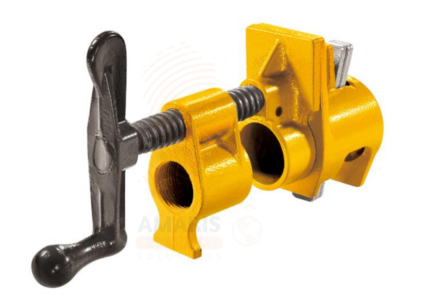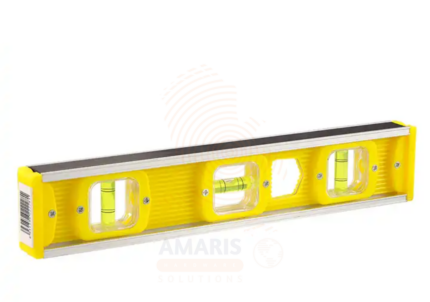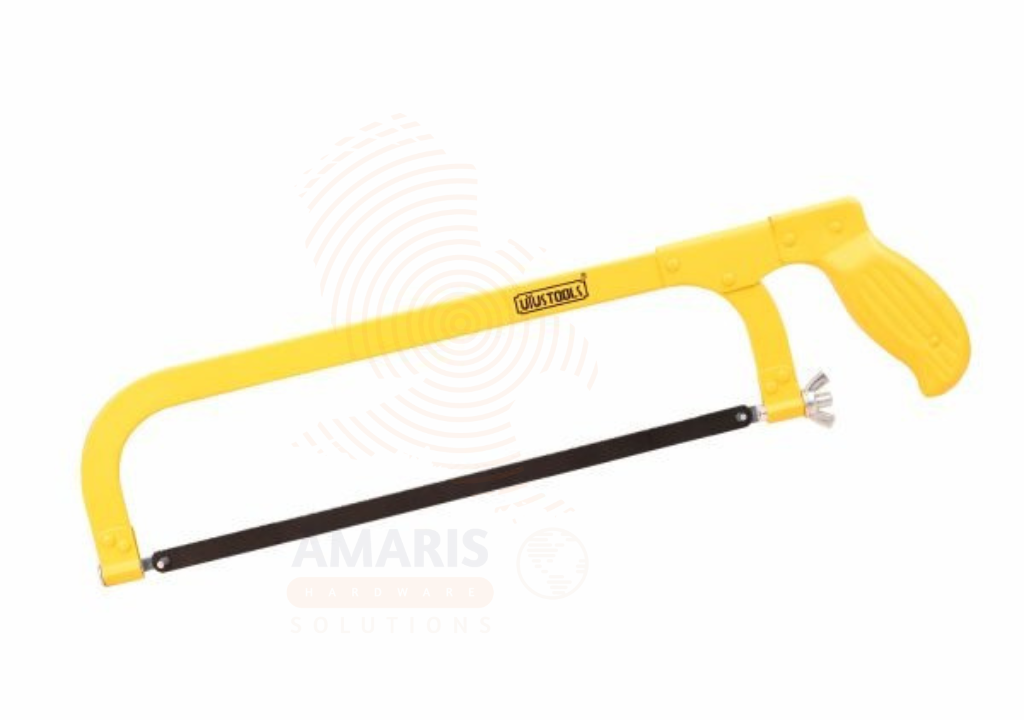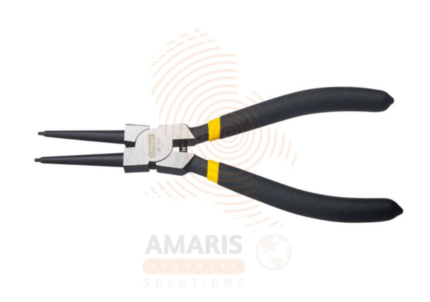

High Tension Plastic Hacksaw
$15.73 Original price was: $15.73.$14.94Current price is: $14.94.
A High Tension Plastic Hacksaw is a cutting tool designed for efficiently and precisely cutting various materials, particularly plastics, with high tension capabilities. It typically features a sturdy frame made of high-tension plastic, which provides increased rigidity and durability during cutting tasks. The term “high tension” refers to the saw’s ability to maintain blade tension at a level that minimizes blade deflection during use, resulting in more accurate and controlled cuts. This type of hacksaw is often equipped with a replaceable blade that has fine teeth suitable for cutting through plastic materials effectively. The design of a High Tension Plastic Hacksaw aims to enhance the overall cutting performance and longevity of the tool, making it well-suited for applications where precision and durability are essential.
Table of Contents
ToggleHigh Tension Plastic Hacksaw
Uses
-
Plastic Cutting:
-
The primary purpose of a High Tension Plastic Hacksaw is cutting plastic materials. It is designed to provide precise and controlled cuts on different types of plastics.
-
-
PVC Pipe Cutting:
-
High Tension Plastic Hacksaws are commonly used for cutting PVC pipes in plumbing and construction projects. The fine-toothed blade allows for clean and accurate cuts.
-
-
Fiberglass Cutting:
-
In industries where fiberglass components are used, a High Tension Plastic Hacksaw can be employed for cutting fiberglass sheets or structures.
-
-
Light Metal Cutting:
-
While primarily designed for plastics, these hacksaws can also handle light metal cutting tasks. This makes them suitable for cutting thin aluminum or non-ferrous metals.
-
-
DIY and Home Improvement:
-
Homeowners and DIY enthusiasts often use High Tension Plastic Hacksaws for various projects, such as cutting plastic pipes, trim, or other materials around the house.
-
-
Electrical Conduit Cutting:
-
In electrical work, these hacksaws are utilized for cutting plastic or PVC conduits to the required lengths.
-
-
Model Making:
-
High Tension Plastic Hacksaws can be useful in model making and crafting projects where precision cutting of plastic components is necessary.
-
-
Automotive Repairs:
-
In automotive repairs and modifications, these hacksaws may be employed for cutting plastic components or trimming materials in the interior.
-
-
Signage and Display Fabrication:
-
Industries involved in signage and display fabrication may use High Tension Plastic Hacksaws for cutting plastic materials to create custom shapes and designs.
-
-
General Purpose Cutting:
-
The versatility of these hacksaws makes them suitable for various general-purpose cutting tasks where a fine-toothed blade and high tension are beneficial.
-
Safety Precautions
-
Wear Personal Protective Equipment (PPE):
-
Always wear appropriate personal protective equipment, including safety glasses or goggles to protect your eyes from debris and potential splinters.
-
-
Use Proper Hand Protection:
-
Wear gloves to protect your hands from sharp edges and to provide a better grip on the hacksaw handle.
-
-
Choose the Right Blade:
-
Ensure that you are using the correct blade for the material you are cutting. Using the wrong blade may result in inefficient cutting or increased risk of accidents.
-
-
Inspect the Hacksaw:
-
Before use, inspect the hacksaw for any damage or defects. Make sure the blade is securely fastened and properly tensioned.
-
-
Secure the Workpiece:
-
Secure the material you are cutting in a stable position, such as using clamps or a vise. This helps prevent the workpiece from moving unexpectedly during cutting.
-
-
Proper Body Position:
-
Stand in a stable and balanced position while using the hacksaw. Ensure that your feet are firmly planted on the ground to maintain balance.
-
-
Appropriate Cutting Speed:
-
Use a controlled and steady cutting speed. Avoid applying excessive force, as this can lead to loss of control and potential injury.
-
-
Direction of Cut:
-
Ensure that the hacksaw is moving in the correct direction. The cutting teeth on the blade should face forward, away from the handle.
-
-
Avoid Overreaching:
-
Do not overreach or stretch too far while using the hacksaw. Maintain a stable and comfortable stance to have better control.
-
-
Mind the Blade Clearance:
-
Be aware of the clearance between the hacksaw frame and the workpiece. Keep fingers and hands away from the cutting path to prevent accidental contact with the blade.
-
-
Steady Pressure:
-
Apply steady and even pressure on the saw while cutting. Avoid forcing the blade through the material, as this may lead to blade breakage or loss of control.
-
-
Store Safely:
-
When not in use, store the hacksaw in a safe and designated location, keeping the blade covered to prevent accidental contact.
-
-
Follow Manufacturer's Guidelines:
-
Adhere to the manufacturer's guidelines and recommendations for the specific High Tension Plastic Hacksaw model you are using.
-


 Acrylic Sealants
Acrylic Sealants Construction Adhesives
Construction Adhesives Double-Sided Tape
Double-Sided Tape Duct Tape
Duct Tape Electrical Tape
Electrical Tape Epoxy & Resins
Epoxy & Resins Masking Tape
Masking Tape
 Automotive Wrenches & Socket Sets
Automotive Wrenches & Socket Sets Battery Chargers & Jump Starters
Battery Chargers & Jump Starters Car Jacks & Stands
Car Jacks & Stands Car Wash & Detailing Products
Car Wash & Detailing Products Diagnostic Tools
Diagnostic Tools Tire Inflators
Tire Inflators Vehicle Lighting
Vehicle Lighting Oil & Lubricants
Oil & Lubricants
 Adhesives & Sealants
Adhesives & Sealants Bricks & Blocks
Bricks & Blocks Cement & Concrete
Cement & Concrete Drywall & Plaster
Drywall & Plaster Flooring (Tiles, Wood, Laminate)
Flooring (Tiles, Wood, Laminate) Lumber & Plywood
Lumber & Plywood Paints, Primers & Coatings
Paints, Primers & Coatings Insulation Materials
Insulation Materials Roofing Materials
Roofing Materials
 Circuit Breakers
Circuit Breakers Electrical Cables & Wires
Electrical Cables & Wires Switches & Sockets
Switches & Sockets Fuses & Relays
Fuses & Relays Connectors & Terminals
Connectors & Terminals Electrical Boxes & Panels
Electrical Boxes & Panels Conduit & Fittings
Conduit & Fittings Lighting Fixtures & Bulbs
Lighting Fixtures & Bulbs Extension Cords & Power Strips
Extension Cords & Power Strips
 Anchors
Anchors Bolts
Bolts Clips & Clamps
Clips & Clamps Screws
Screws Nuts
Nuts Washers
Washers Rivets
Rivets Nails
Nails Threaded Rods
Threaded Rods
 Hammers
Hammers Measuring Tools (Tapes, Levels, Calipers)
Measuring Tools (Tapes, Levels, Calipers) Screwdrivers
Screwdrivers Pliers & Cutters
Pliers & Cutters Saws & Blades
Saws & Blades Chisels & Punches
Chisels & Punches Allen Keys & Hex Keys
Allen Keys & Hex Keys Ratchets & Socket Sets
Ratchets & Socket Sets Wrenches & Spanners
Wrenches & Spanners
 Power Tool Accessories (Blades, Bits, Discs)
Power Tool Accessories (Blades, Bits, Discs) Rotary Tools
Rotary Tools Saws (Circular, Jigsaw, Reciprocating)
Saws (Circular, Jigsaw, Reciprocating) Drills & Drivers
Drills & Drivers Grinders & Sanders
Grinders & Sanders Heat Guns
Heat Guns Nail Guns
Nail Guns Impact Wrenches
Impact Wrenches Batteries & Chargers
Batteries & Chargers
 Pipes & Fittings (PVC, Copper, PEX)
Pipes & Fittings (PVC, Copper, PEX) Plumbing Tools
Plumbing Tools Pumps & Motors
Pumps & Motors Sealants & Adhesives for Plumbing
Sealants & Adhesives for Plumbing Valves & Taps
Valves & Taps Water Heaters
Water Heaters Drainage Systems
Drainage Systems Faucets & Fixtures
Faucets & Fixtures Hoses & Tubing
Hoses & Tubing
 Hinges & Latches
Hinges & Latches Hooks & Brackets
Hooks & Brackets Window Hardware
Window Hardware Chains & Cables
Chains & Cables Casters & Wheels
Casters & Wheels Shelving & Storage Systems
Shelving & Storage Systems Door Handles & Locks
Door Handles & Locks Drawer Slides & Cabinet Hardware
Drawer Slides & Cabinet Hardware
 Personal Protective Equipment (PPE)
Personal Protective Equipment (PPE) Respirators & Masks
Respirators & Masks Safety Glasses
Safety Glasses Safes
Safes Security Cameras
Security Cameras Gloves
Gloves Helmets
Helmets Ear Protection
Ear Protection Fire Safety Equipment
Fire Safety Equipment Locks & Padlocks
Locks & Padlocks Motion Sensors & Alarms
Motion Sensors & Alarms
 Garden Fencing
Garden Fencing Garden Furniture Hardware
Garden Furniture Hardware Lawn Mowers
Lawn Mowers Trimmers & Edgers
Trimmers & Edgers Shovels & Spades
Shovels & Spades Rakes & Hoes
Rakes & Hoes Pruning Shears & Loppers
Pruning Shears & Loppers Watering Systems (Hoses, Sprinklers, Nozzles)
Watering Systems (Hoses, Sprinklers, Nozzles)
 Interior Paints
Interior Paints Paint Brushes & Rollers
Paint Brushes & Rollers Paint Strippers & Thinners
Paint Strippers & Thinners Paint Trays & Accessories
Paint Trays & Accessories Exterior Paints
Exterior Paints Spray Paints
Spray Paints Primers & Undercoats
Primers & Undercoats Varnishes & Stains
Varnishes & Stains
 Gaskets & Seals
Gaskets & Seals Hydraulic Fittings
Hydraulic Fittings Industrial Fasteners
Industrial Fasteners Industrial Hoses
Industrial Hoses Lubricants & Greases
Lubricants & Greases Metal Sheets & Bars
Metal Sheets & Bars Bearings & Bushings
Bearings & Bushings Belts & Pulleys
Belts & Pulleys
 HVAC Filters
HVAC Filters Insulation for HVAC
Insulation for HVAC Air Conditioners
Air Conditioners Refrigerants
Refrigerants Ventilation Ducts & Fittings
Ventilation Ducts & Fittings Thermostats & Controllers
Thermostats & Controllers Fans & Blowers
Fans & Blowers
 Pegboards & Hooks
Pegboards & Hooks Shelving Units
Shelving Units Storage Bins & Containers
Storage Bins & Containers Toolboxes & Tool Chests
Toolboxes & Tool Chests Workbenches
Workbenches Drawer Organizers
Drawer Organizers Labeling Supplies
Labeling Supplies
 Welding Accessories (Clamps, Brushes)
Welding Accessories (Clamps, Brushes) Welding Electrodes & Rods
Welding Electrodes & Rods Welding Helmets & Gloves
Welding Helmets & Gloves Welding Machines
Welding Machines Soldering Irons & Stations
Soldering Irons & Stations Flux & Solder Wire
Flux & Solder Wire
 Generator Accessories
Generator Accessories Inverters
Inverters Portable Generators
Portable Generators Power Inverters
Power Inverters Transfer Switches
Transfer Switches Diesel & Gasoline Generators
Diesel & Gasoline Generators
 Transport Equipment: Carts, Dollies, and Hand Trucks
Transport Equipment: Carts, Dollies, and Hand Trucks Storage Solutions: Pallets, Racks, and Containers
Storage Solutions: Pallets, Racks, and Containers Lifting Equipment: Hoists, Cranes, and Jacks
Lifting Equipment: Hoists, Cranes, and Jacks Conveyors and Accessories: Belts and Rollers
Conveyors and Accessories: Belts and Rollers








